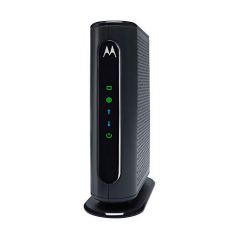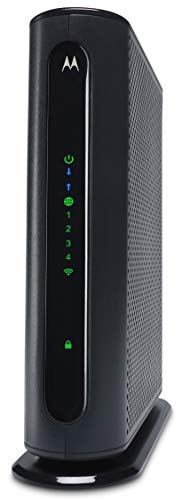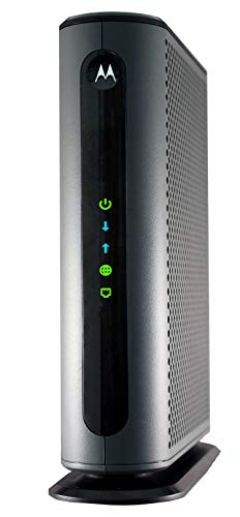BestReviews is reader-supported and may earn an affiliate commission. Details

Motorola has gone above and beyond with this blazingly fast cable modem. If you need the fastest and most consistent internet connection available, this is the device you are looking for.
Hands down, the ultimate high-speed cable modem made by Motorola. Perfect for streaming 4K content, video conferencing, online gaming, etc. Many compatible internet providers.
Not all internet providers support this elite modem.

A sturdy and capable DOCSIS 3.0 modem that's easy to set up with the major internet providers.
Recommended for most households not requiring gigabit speeds. DOCSIS 3.0 attains real-life speeds up to 650 Mbps. Compatible with Comcast, Cox, Spectrum, BrightHouse and others. Built-in power surge protection.
Problems are rare, but Motorola’s support processes are lackluster.

A simple, no-frills cable modem solution that provides authentically fast internet speeds at a great price.
Genuinely fast internet speed. Gigabit Ethernet port for superior speed when devices are directly plugged in. Available in white or black. Built-in lightning and power surge protection.
Router sold separately. There are speedier cable modems available from Motorola.

An excellent way to save on buying separate modem and router devices, and its good speed and superior Wi-Fi broadcasting range give it additional value.
Features built-in Wi-Fi router. Easy installation. Power Boost feature amplifies your wireless signal to the legal limit for maximum home or office coverage. Approved by a wide range of internet providers.
This isn’t the fastest Motorola cable modem available, but this model will absolutely blanket the area with a solid Wi-Fi connection.

If you can get over the initial cost, this ultra high-speed cable modem may be the best choice for heavy internet users, Netflix binge-watchers, Xbox players, and anyone who works from home.
Can deliver over 1 Gigabit per second. Excellent high-speed internet for online gaming, video streaming, and general internet usage. Compatible with all routers. Certified by Comcast and Cox Communications.
This model is one of the most expensive cable modems available from Motorola.

We recommend these products based on an intensive research process that's designed to cut through the noise and find the top products in this space. Guided by experts, we spend hours looking into the factors that matter, to bring you these selections.

Many factors can contribute to underperforming home internet service, but a major one is the equipment one uses. Most ISPs (internet service providers) will rent a modem to residential customers, but these tend to be bare-bones models that are slower or less reliable. Purchasing your own modem (and/or router) not only can help deliver the kind of internet connection you desire, but usually does so with a long-term savings.
While many manufacturers make modems, Motorola is a brand with a long track record, and that familiar name gives it broad appeal. When choosing a Motorola modem, you should first ensure that the model is compatible with your ISP. After that, let the features you desire or expect to use guide you to a comfortable decision.
In this guide, we explore the array of features and considerations available with Motorola modems.

When seeking a Motorola modem, you first will need to determine whether you want simply a modem by itself or a modem-router combination. Motorola offers several models that fit either category.
With either type of modem from Motorola, the format will be a vertically aligned piece of hardware that’s almost the size of a hardcover book.
Most residential users choose a modem-router combination. A router is hardware that allows the modem to share data with devices that are connected wirelessly or with cables. Having both functions bundled in one device is a convenience.
The Motorola modem-router combination allows the creation of a WiFi network, but the device also includes ports on the back for making hard-wired connections. The majority of Motorola modem-routers have four Ethernet ports, at least one of which supports Gigabit Ethernet speeds.
Motorola modem-router combinations nearly always support dual-band WiFi, meaning it can choose between the faster 5 GHz band or the previous-standard 2.4 GHz band. This ability to alternate between the two bands allows the device to avoid interference on either of the bands, improving the performance and reliability of your WiFi network.
If you pick a standalone model from Motorola, it will have only one Ethernet port on the back, used for connecting the separate router, which would then give you the ability to create a WiFi network.
Some cable ISPs do not allow customers to use a combo modem-router, so this is a case where you’d have to go with a modem-only piece of hardware and add a router on your own.
If you have older devices connected to the Motorola modem that do not support the current security standards, you can change settings to be in line with the older devices’ security protocols.
Motorola modems offer a number of features. Before buying, it’s important to understand the options and decide which to prioritize based on your planned uses.
DOCSIS, short for Data Over Cable Service Interface Specification, is a protocol used in modems. Some Motorola cable modems support DOCSIS 3.1 (the fastest current standard), allowing for maximum data transfer speeds and the most reliable connection signals. Others support the previous standard, DOCSIS 3.0, which still delivers plenty of speed for most residential users.
Some ISP subscriptions don’t have enough data transfer speed to justify using DOCSIS 3.1, but the standard is backward-compatible with older versions of DOCSIS. So while buyers may save a little with a DOCSIS 3.0 modem, it comes at the expense of missing potential future upgrades by the ISP.
AQM is a technology available under DOCSIS 3.1 in some Motorola modems that uses software to speed up high-bandwidth processes such as online gaming or videoconferencing.
Motorola modems use separate upload and download channels. The more channels a modem has, the faster its potential data transfer speed.
Most modems have more download channels than upload channels, as users download far more data than they upload. Motorola modems have 8 to 32 channels for downloading and 4 to 8 upload channels. The cost of a modem typically rises with the number of channels, but the increased performance will be well worth it for those who stream video or play online games.
Those who choose a telephone/internet bundle from their service provider will want a Motorola modem-router with telephone jacks.
A related option with some Motorola modems is a backup battery that powers the phone for several hours in the case of a loss of power at home.

Lower-end: Motorola modems generally cost a little more than modems from most other manufacturers. For the most basic modems from Motorola, expect to pay between $50 and $100. These typically are modem-only pieces of hardware.
Higher-end: For a modem-router combination from Motorola, prices range from $75 to $250. Pricier models deliver the most speed and performance.
To determine whether purchasing your own Motorola modem makes financial sense, find out what you are paying your ISP each month to rent equipment. It’s likely that, by purchasing a modem and not paying rental fees, the device would pay for itself within 18 months.
Using a Motorola modem at the same coaxial wall outlet that connects your TV will require a coaxial splitter.
If you are having trouble with your Motorola modem or modem-router, try these troubleshooting tips.

A. Not necessarily. Some Motorola modem-routers give you the ability to create a guest network that is separate from your password-secured network. Guests can access the network without risk of them gaining access to your personal files.
A. Yes, as long as it is a modem-router combination. If it is a modem-only, you must connect the TV to the router that is connected to the modem.
A. Not really, although some people have the devices professionally installed. Much of the time, your devices can access the modem-router automatically, which makes things extremely easy during setup. However, if you want to control all aspects of the modem’s features and connectivity, you can adjust these advanced settings through the software included with the modem.
A. Yes. In fact, turning off the modem for up to a minute on a regular basis can promote a more reliable internet signal.
Get emails you’ll love.
Learn about the products you’re wondering if you should buy and get advice on using your latest purchases.
